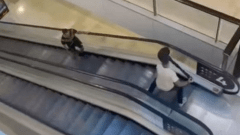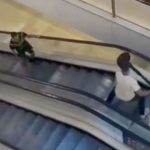
I used to love the zoo as a kid, as all kids do. Then, I got older, and began to view all zoos like animal prisons. For a while, I hated zoos. Then, I got even older, and realised that zoos, when run properly and with good intentions, are integral to the survival of so many species.
While some zoos around the world can literally be classified as depressing animal prisons — I’ve seen and heard of plenty while travelling across Asia and Europe — we’re lucky in this country to have zoos that truly care about the animals they look after. Zoos Victoria, for example, employ top-notch scientists and vets, and play a vital role in supporting research to help fight extinction.
And it’s a huge fight to undertake. Many species across the globe are under threat — at risk of being confined to the pages of history books unless action isn’t taken soon. To help put an adorable face to this fight, we’ve rounded up 27 species that could be lost forever in the next decade. Luckily, Zoos Victoria is at the forefront of the fight to save every species listed below.
Enjoy the cuteness overload.
Alpine She-oak Skink

Omg look at its cute lil tongue!! This smooth operator can be found in only a few locations in Victoria and NSW, and lives about 1,500 metres above sea level on top of isolated mountain habitats. It does its best snake imitation when threatened by tucking in its legs and flicking out its tongue. Big flex, big snake energy.
Baw Baw Frog

Current estimates show that the Baw Baw frog could be extinct in the wild within decades if we don’t act fast. Melbourne Zoo is currently leading the way in helping save the Baw Baw through a breeding program and the wild release of adult frogs and eggs on the Mt Baw Baw.
Brush-tailed Rock-wallaby (southern population)

In Victoria, the Brush-tailed Rock-wallaby now exists in only two small and isolated locations, with less than 30 of them in each place.
Eastern Barred Bandicoot (mainland population)

The Eastern Barred Bandicoot was thought extinct in the wild up until a few weeks ago (yay!). This is thanks to the combined efforts of a bunch of organisations, led by the Victorian government, as well as volunteers and communities. Thanks to this, Zoos Victoria has been able to end its breeding program. We love to see it.
Giant Burrowing Frog

This elusive little chunker is one of Victoria’s most poorly understood species. Wild populations of the Giant Burrowing Frog are in decline, but Melbourne Zoo is now caring for dozens of young frogs and learning more each day about how to breed them up.
Golden-rayed Blue Butterfly

This lil fly guy lives in the narrow bands of remnant floodplains that border a handful of salt lakes in the west of Victoria. It’s sadly listed as Critically Endangered, so Zoos Victoria is studying its wild habitat to learn more about where and how these little beauties live.
Grassland Earless Dragon (Victorian species)

The Grassland Earless Dragon has not appeared in Victoria since 1969, although Zoos Victoria is still searching for it. Melbourne Zoo has also had great success breeding the closely related Grassland Earless Dragon from Canberra.
Guthega Skink

This cute lil skink is endangered in Victoria and is only found on the Bogong High Plains. Another population lives near Mt Kosciuszko in NSW, but the two populations have not been connected for millions of years. Long time between drinks.
Helmeted Honeyeater

This creature is the bird emblem for Victoria and, although it is sadly listed as Critically Endangered, captive breeding has helped the last remaining population grow from just 50 to 250 birds. So, this year a second population was formed in the depths of the Yarra Ranges National Park.
Key’s Matchstick Grasshopper

This flightless grasshopper hasn’t been seen in VIC for decades, until a rediscovery near Omeo in 2019. Zoos Victoria is supporting research from Melbourne University to discover more about it, and is undertaking field surveys to identify any remaining Victorian populations.
Large Brown Tree Frog

This lil guy is one of the least understood amphibian species in Victoria. Like all Aussie frogs, it’s threatened by Chytridiomycosis — a skin infection caused by Chytrid fungus.
Leadbeater’s Possum (Lowland population)

This little possum came back from the dead in 1961 when it was rediscovered after being thought extinct, though it is still listed as endangered. In 1971, it was declared one of Victoria’s faunal emblems.
Lord Howe Island Stick Insect

The Lord Howe Island Stick Insect was also once thought extinct until it was rediscovered in 2001 on Ball’s Pyramid, a volcanic outcrop 23 km off the coast of Lord Howe Island. It’s still Critically Endangered, but Melbourne Zoo has run a successful breeding program for almost 20 years, with the aim of returning the species to its island home.
Mallee Emu-Wren

The Mallee Emu-Wren population has been decimated by bushfires — it was declared extinct in South Australia after a series of bushfires.
Mountain Pygmy-possum

Another species once thought to be extinct only to be rediscovered at Mt Hotham in the 1960s, though sadly less than 2,000 of them can be found in the wild. The Mountain Pygmy-possum Recovery Team is now fighting to save this critically endangered species.
New Holland Mouse

This adorable little mouse is under severe threat from loss of habitat and predators like feral cats and foxes. It is classified as extinct in seven out of its 12 known Victorian locations.
Northern Corroboree Frog

This psychedelic looking dude is tiny — measuring in at a whopping 2.5 – 3cm in length. Populations of the Northern Corroboree Frog have sadly experienced great decline in the last few decades.
Orange-bellied Parrot

This colourful little beauty is one of the last migratory parrot species left in the world, it’s listed as Critically Endangered. Each year, Zoos Victoria and wildlife partners breed and release flocks of the parrots into the wild to build populations and learn more about this fascinating species.
Plains-wanderer

In evolutionary terms, Plains-wanderers are one of a kind — there’s no bird like it in the world. It’s also Critically Endangered and under imminent threat of extinction. This year, eight precious Plains-wanderers from Werribee Open Range Zoo’s breeding program were released into the wild for the first time, marking a major milestone in the recovery of the species.
Regent Honeyeater

This bird has a soft, almost metallic chiming call — though unfortunately it is rarely heard as the species has been in decline since the 1940s. Recently, researchers have been teaching the rare birds to sing their song once again by playing recordings.
Smoky Mouse

In Victoria, the Smoky Mouse is extinct in two of its four known locations, though you can still find them in the Grampians, and in fragmented areas within the Central Highlands.
Southern Bent-wing Bat

These micro-bats have an ultrasonic call that is imperceptible to humans unless we use special bat detectors. They’re also ace pest controllers, eating at least half their body weight in insects each night. They’re also, unfortunately, on the Critically Endangered list.
Southern Corroboree Frog

This little legend is one of the country’s best-known frogs, it’s also listed as Critically Endangered.
Spotted Tree Frog

As far as frogs go, the lifespan of the Spotted Tree Frog is quite long — they can live up to ten years! It can now only be found in very few mountain streams, and is listed on the Critically Endangered list, so some frogs have been collected to form a captive-bred population.
Stuttering Barred Frog (southern population)

This little frog is only 80mm in length!! It’s fast disappearing in the wild, and hasn’t been spotted in Victoria since 1983, with some believing it already extinct in the wild in Victoria.
Swift Parrot

According to Zoos Victoria, there’s a 31% likelihood this parrot will become extinct over the next 20 years, unless we can solve the issues surrounding its continued existence.
Tasmanian Devil

Last, but certainly not least, the iconic Tassie Devil. It is the largest living carnivorous marsupial, and once lived on mainland Australia, but can now only be found in its namesake state. Healesville Sanctuary (Zoos Victoria) and Save the Tasmanian Devil breeding recovery program aims to have an insurance population to ensure a long-term future.
If you’ve come this far and you’re feeling a little bummed, I have a silver lining for you — it’s not over til the fat bandicoot sings! Sure, every species above is in very real danger, but the good news is they’re still with us, and as long as they’re around, we can rest assured that organisations like Zoos Victoria will do their utmost to keep it that way.
The fight against extinction isn’t an easy one, but it’s not impossible. You can make a difference, today — head over to the Zoos Victoria site to find out more, and check out this adorable vid below to see how they’ve been fighting extinction over the past year.







